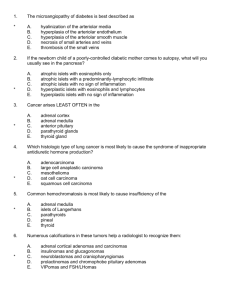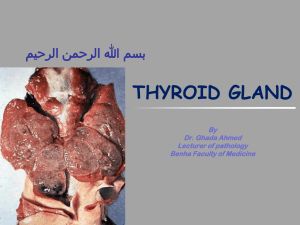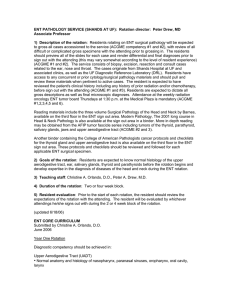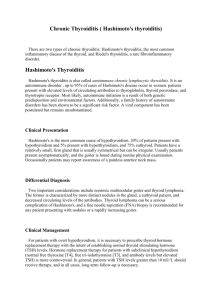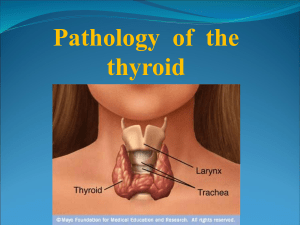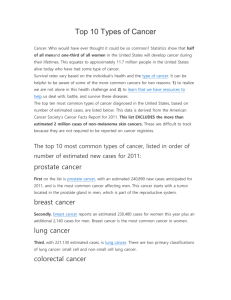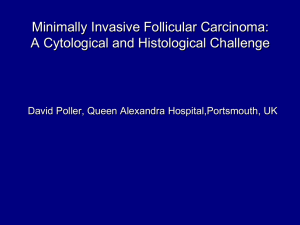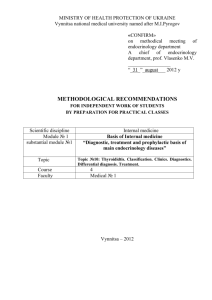Endocrine, 2004-2005
advertisement
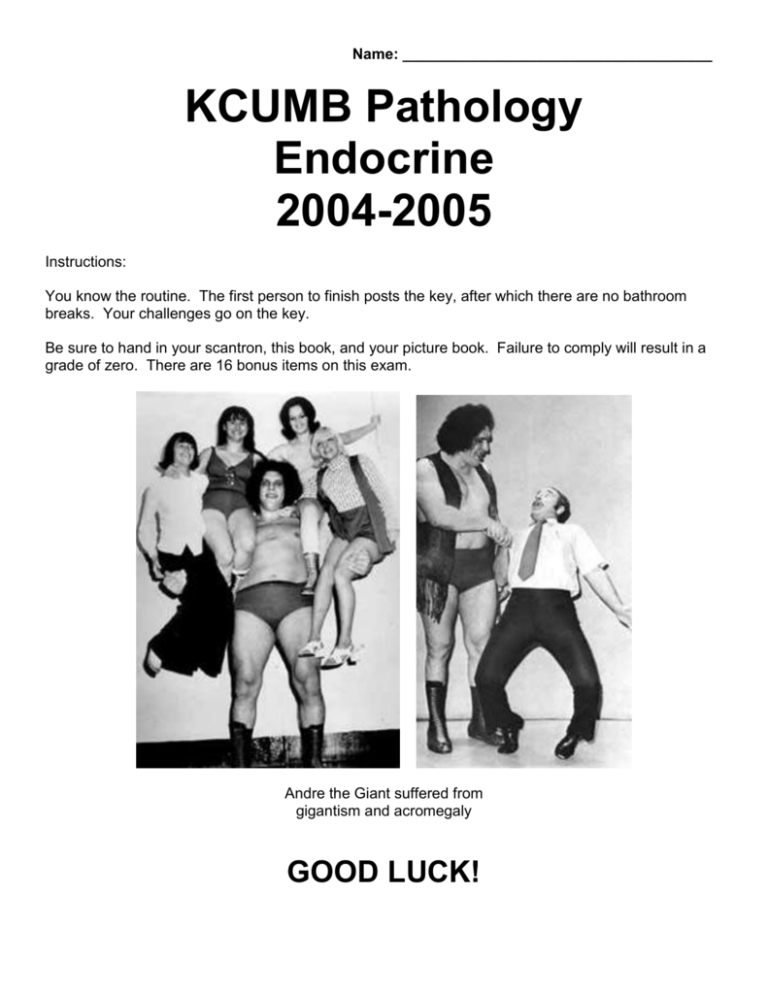
Name: _____________________________________ KCUMB Pathology Endocrine 2004-2005 Instructions: You know the routine. The first person to finish posts the key, after which there are no bathroom breaks. Your challenges go on the key. Be sure to hand in your scantron, this book, and your picture book. Failure to comply will result in a grade of zero. There are 16 bonus items on this exam. Andre the Giant suffered from gigantism and acromegaly GOOD LUCK! 1. Which syndrome does NOT place a person at increased risk for pheochromocytoma? * A. B. C. D. E. 2. Sheehan's syndrome is destruction of the anterior pituitary as a complication of * A. B. C. D. E. 3. Cancer arises LEAST often in which endocrine gland? * A. B. C. D. E. multiple endocrine neoplasia type I multiple endocrine neoplasia type II-A mutant succinic acid dehydrogenase neurofibromatosis von Hipppel-Lindau autoimmunity enlarging tumor of any sort obstetrical shock sickle cell disease surgery for Cushing's disease adrenal cortex adrenal medulla pineal pituitary thyroid 4. TWO PHOTOS. Classic patient and her thyroid gland. Judging by the histology, this is: * A. B. C. D. E. 5. THREE PHOTOS. Three children. What is the diagnosis? * A. B. C. D. E. 6. TWO PHOTOS. Sella turcica region and photomicrograph. What is the diagnosis? * A. B. C. D. E. Graves's disease, not treated effectively Graves's disease, now fully controlled with radio-iodine Graves's disease, temporarily suppressed with iodine Graves's disease, temporarily suppressed with propylthiouracil Jod-Basedow phenomenon, too-rapid replacement of iodine achondroplasia congenital adrenal hyperplasia congenital hypothyroidism pituitary dwarfism neuroblastoma paraneoplastic effect / "blueberry muffin" craniopharyngioma granular cell hamartoma metastatic squamous cell carcinoma no pathology pituitary adenoma 7. ONE PHOTO. Radiograph of both knees. Which is most likely? * A. B. C. D. E. 8. ONE PHOTO. Scan image of the head. The very radiodense lesion is most likely a: * A. B. C. D. E. 9. FOUR PHOTOS. Thyroid gland. What is the diagnosis? * 10. A. B. C. D. E. fibrous dysplasia in McCune-Albright metastatic carcinoma consistent with thyroid primary neuropathic arthropathy in a diabetic ("Charcot's joints") osteoporosis consistent with Cushingism parathyroid bone disease craniopharyngioma pinealoblastoma pinealoma pineocytoma pituitary adenoma DeQuervain's thyroiditis Hashimoto's thyroiditis iodine deficiency goiter Riedel's thyroiditis no pathology TWO PHOTOS. Adrenal gland. The red-and-white variegated color of the gross lesion is typical. What is the diagnosis? * A. B. C. D. E. 11. FIVE PHOTOS. Thyroid gland. What is the diagnosis? * A. B. C. D. E. congenital adrenal hyperplasia cortical adenoma metastatic oat cell carcinoma of the lung neuroblastoma pheochromocytoma de Quervain's thyroiditis follicular carcinoma idiopathic nodular goiter papillary carcinoma undifferentiated anaplastic carcinoma 12. TWO PHOTOS. Liver. Your patient probably also has * A. B. C. D. E. Cushingism hypercalcemia hypocalcemia hypothyroidism secondary diabetes 13. * TWO PHOTOS. Bone. This is probably A. B. C. D. E. a healing pathologic fracture in Cushingism hyperparathyroidism McCune-Albright fibrous dysplasia metastatic follicular thyroid cancer metastatic neuroblastoma 14. TWO PHOTOS. Anterior mediastinal mass. This is a(n) * A. B. C. D. E. 15. TWO PHOTOS. Adrenal gland opened at surgery. What is the diagnosis? * A. B. C. D. E. 16. TWO PHOTOS. Patient plus adrenals from autopsy. What is the syndrome? * A. B. C. D. E. abscess Hodgkin's disease mediastinal embryonal cell carcinoma (Brian Piccolo's disease) substernal goiter thymoma cortical adenoma metastatic oat cell carcinoma of the lung neuroblastoma pheochromocytoma tuberculosis Conn's Nelson Schmidt Waterhouse-Friderichsen Zollinger-Ellison 17. TWO PHOTOS. Neck organs. What is the diagnosis? * A. B. C. D. E. 18. ONE PHOTO. Resected thyroid lobe. On the "gross", you're betting it's * A. B. C. D. E. de Quervain's thyroiditis with thyromegaly follicular thyroid cancer idiopathic nodular goiter papillary thyroid cancer Riedel's struma a follicular adenoma a nodular goiter an anaplastic carcinoma an infarct Graves's disease 19. ONE PHOTO. Oral mucosa. You suspect * A. B. C. D. E. 20. ONE PHOTO. The rash suggests * A. B. C. D. E. 21. ONE PHOTO. This patient most likely has what syndrome? * A. B. C. D. E. 22. ONE PHOTO. Pancreas from a recent-onset diabetic. What's the diagnosis? * A. B. C. D. E. 23. ONE PHOTO. Congo red stain of a thyroid lesion. What's the diagnosis? * A. B. C. D. E. 24. TWO PHOTOS. Adrenal gland. What's the diagnosis? * A. B. C. D. E. Addison's disease Cushingism with oral thrush hyperparathyroidism MEN-IIb with mucosal neuromas pernicious anemia with mucositis addisonism from any cause Bartter's syndrome glucagonoma the Somogyi phenomenon VIPoma Crooke's hyaline change Goldblatt's hypertension McCune-Albright pseudopseudohypoparathyroidism Schmidt's polyendocrine autoimmune adenocarcinoma cystic fibrosis hemochromatosis with secondary diabetes type I (juvenile-onset) diabetes type II (adult-onset) diabetes anaplastic thyroiditis idiopathic nodular goiter medullary carcinoma non-neoplastic amyloid goiter papillary carcinoma cortical adenoma cortical carcinoma metastatic adenocarcinoma neuroblastoma pheochromocytoma BONUS ITEMS: 25. What does the eponym "MODY" stand for? [maturity onset diabetes in the young, I need “diabetes” and “young” and a reasonable pair of answer for M and O] 26. The classic "basophilic adenoma" of the pituitary typically makes which hormone? [ACTH; FSH/LH isn’t classic and isn’t one hormone, sorry] 27. Hashimoto's thyroiditis places a person at increased risk for what cancer arising in the thyroid gland? [lymphoma; “Hurthle cell carcinoma” isn’t an answer] 28. Killham rat virus infection resembles what human illness? [diabetes is sufficient] 29. People with classic Graves's disease are prone to develop localized areas of increased ground substance on the skin at what location? Be specific. [pretibial; shins, accept leg; knee is not acceptable, “behind the eye” isn’t skin] 30. In people who have goiters due to eating a great deal of cabbage or some other goitrogen, the gland tends to be very cellular, with tall cells and very little colloid. Explain why. [something about overstimulation by TSH is plenty; or any explanation involving iodine trapping making the gland not function. Cabbage is not especially rich in iodine.] 31. Big doses of the anti-fungal agent ketoconazole given systemically can produce what endocrine disturbance? [addisonism / adrenal insufficiency; accept gyncomastia, cortical hyperplasia, shunting steroids to androgens] 32. What's the usual cause of "pituitary apoplexy"? [hemorrhage into an adenoma; sorry, none others acceptable] 33. The genes IDDM1 and IDDM2 are ImplicateD in what form of Diabetes Mellitus? [type I / autoimmune] 34. What's "Good's syndrome", seen in thymoma? [hypogammaglobulinemia / depressed B cells / depressed plasma cells; also accept red cell aplasia / an answer of “anemia” is sufficient only if you mention decreased production or a normoblast problem] 35. Homovanillic acid is the classic urine screen for what tumor? [neuroblastoma. It is not the CLASSIC test for pheochromocytoma.] 36. What do we mean by an "oncocyte"? [cells packed with mitochondria / Hurthle cells. “Oncocyte” does not in any way imply anything about tumors.] 37. What lab test will you probably order to screen for growth hormone deficiency? HINT: You do not have to do a stimulation or suppression test. [IGF / IGF-I] 38. What's the eponym for the common, mild, self-limited disease in which the thyroid epithelial cells are damaged and there is a granulomatous response to the colloid? [de Quervain's] 39. Briefly explain why older textbooks give much higher "normal" weights for autopsy adrenals than we accept today. [stress of illness; dissection techniques were the same] 40. Suggest a reason for the greatly increased rate of glaucoma in people who are diabetic. [+1 for any reasonable answer]
